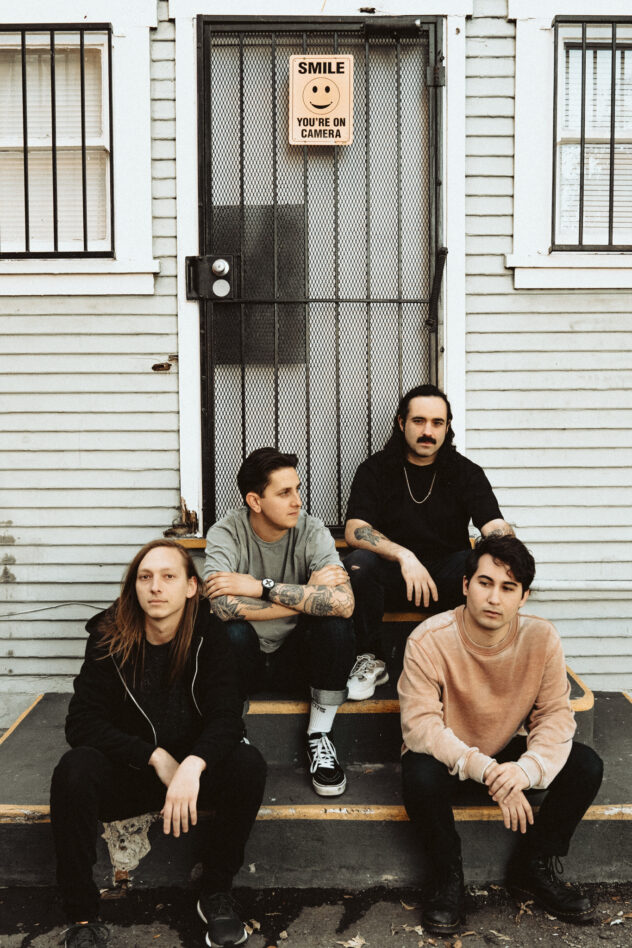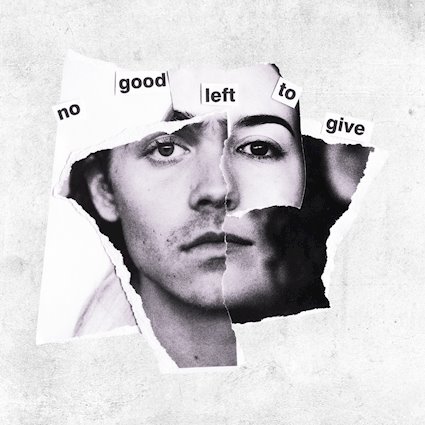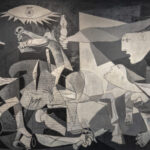Interview: Movements Hope Fans Are Ready to Grow with Them
Posted: by admin

The first three minutes of Movements’ second LP, No Good Left to Give, are less a full-fledged track and more a thesis statement for the album to follow. Moody, slow, and contemplative,“In My Blood” sets the tone for the quartet’s second full-length album. Three years after 2017’s Feel Something, the mood is heavier but the sentiment is the same: “I feel so fucked / At least I’m feeling,” vocalist Patrick Miranda belts in the opening track. “We wanted this album to have more depth than our previous collections of songs,” Miranda says by phone a couple weeks before the album’s release. “We wanted it to feel more rich and more mature in every aspect.”
Miranda was 19 when Southern California-based Movements formed and released their first demo, “Protection,” in 2015. The early music, including breakout EP Outgrown Things (2016), resonated with fans immediately for its unvarnished, guttural anger and energy—unleashed in every one of Miranda’s screams—as well as the poetic spoken word that became a trademark early on. Now 24, however, with more albums and countless tours under his belt, Miranda and Movements—Ira George (guitar), Spencer York (drums), and Austin Cressey (bass)—have grown immensely. That growth is reflected in their evolving sound, changes they have embraced completely. Movements are not interested in being a band that scrambles to conform to the sound of the moment or takes its cues from other artists. Hopefully, fans are interested in sticking around for the ride.
Early on, Miranda acknowledges that a fledgling Movements may have taken too many cues from the post-hardcore sound that was dominant at the time. “In my personal opinion, I wanted our band to sound like La Dispute and Pianos Become the Teeth. There was some mimicry involved in that specific era, 2012 to 2017, 2018—that particular sound,” Miranda says. “We’ve decided we don’t need to sound like anybody else, we don’t need to draw influence from anything in our world; we can just make stuff that we think sounds cool and have it be our own. That was something we tried to do with this record especially.”
Longtime Movements fans will immediately notice the shortage of screaming on No Good Left to Give, though there’s plenty of belting. There isn’t nearly as much spoken word as on earlier releases, either. “I feel like I’m a singer through and through. I’m classically trained. I want to show off my abilities,” Miranda says. “I just wanted to do mostly singing on this record because that’s what I like.” But it was also important to Miranda to include a “tether that connects the past and present,” and fans will find that in the fourth track and final single, “Tunnel Vision,” which would have easily been at home on Feel Something. “Then people know there’s some callbacks to stuff we’ve always done and always will do,” Miranda says.
The week No Good Left to Give is set to debut, Movements haven’t all been together in about six months. One member lives in an immunocompromised household, and the band has been extremely cautious overall. On Friday, to celebrate the album’s release, Miranda, George, and Cressey will get together at a rooftop spot they found for a Twitch livestream, where they’ll play three songs from the new album and two old ones, as well as answer fans’ questions and hang out. An audio engineer friend will mix the stripped-down set live. “It’s not super polished or anything; it’s just for fun and to get that interaction with our fans,” Miranda says.

It’s one of the many raw deals of releasing an album amid a pandemic that has halted live performances—in No Good Left to Give, Movements have an album that was written to sound killer live. On this record in particular, Miranda says, the band wanted to make their music sound really “big.” “There’s a vastness and an expansiveness to it, and there are a lot of layers in there, different parts, instruments we experimented with on this album,” Miranda says. In writing—the most collaborative effort the band has had so far—Movements were aware how great these songs could sound like. But at the same time, “as much as we want these songs to be felt and experienced live, they also translate to a listening scenario,” Miranda says. Listening to No Good Left to Give with a pair of really great headphones will yield different results than, say, your computer speakers.
The foursome believes albums are meant to be played front to back, and longtime producer Will Yip was instrumental in nailing down No Good Left to Give’s sequence. “Shuffling an album is the worst thing you can do for the integrity of the music,” Miranda says. “The songs were written and recorded and placed to be played precisely in that order.” While the band considered multiple possible sequences for Feel Something, many tracks on No Good Left to Give were locked into place immediately. “In My Blood” is an ominous, atmospheric track that establishes the exact tone the band wanted, and then the No. 2 spot, typically reserved for bangers, is energetic, dancy “Skin to Skin.” The middle tracks ebb and flow in heaviness, and then interlude “No Good Left to Give” sets up closer “Love Took the Last of It,” establishing a refrain that comes back to be repeated in the end track. “It’s the most well-sequenced album we’re written so far,” Miranda says.
The writing process was also as democratic as it’s ever been. Even though Miranda doesn’t play an instrument, he has equal say in what George, York, and Cressey do on their guitar, drum, and bass parts, respectively. Likewise, the latter three have just as much say in Miranda’s lyrics and melodies. All four members are deeply involved in the songwriting process; typically, George will come to the table with a guitar riff, and they’ll build the song from there. For this record in particular, since the band was on tour during most of the writing window, they wrote mostly on a computer, tracking “shitty demos” and building the songs piece by piece that way, rather than all sitting in a practice space together.
That’s how “Skin to Skin,” perhaps the biggest outlier in Movements’ discography to date, came to be. It started off as a joke. George was experimenting with a digital pedalboard on his laptop that allows him to play with different guitar effects and pedals when he doesn’t have access to a full set-up. When he came up with the opening riff, “he was laughing to himself,” Miranda says. “He thought it was so ridiculous. It was just him playing those notes with a super delayed effect so it creates this weird staccato delay, and the other effects on it make it sound like a synthesizer.”
George shared the riff with the band and almost didn’t believe Miranda actually wanted to write a song around it. “I was like, ‘That’s fucking sick.’ It reminded me of ‘Everybody Wants to Rule the World’ by Tears for Fears,” Miranda laughs. Determined to save the song from the scrap pile, Miranda suggested some of the additional instrumental parts. “I started being like, ‘It’d be sick if we had a part underneath it to give it that extra vibe; for the chorus, what if we just did something fast.” He came up with what we mutually termed the “duh duh duh duh duh” that accompanies the transition into the chorus—a minor melody that keeps the song from veering too far into goofiness and lends it its melancholic edge. “I was vibing with it super hard and I was like, ‘Let’s go, we have to write this song.’”
The band took that demo to Yip, and Miranda flew out to the studio a month or two before they went in to record the album to write vocal parts for six songs in three days with Yip. “Will was a big help in figuring out those melodies and how the song should be structured,” Miranda says. The former choir kid is all too happy to break down his vocal part. In the chorus of “Skin to Skin,” when he reaches his higher register, his voice naturally registers some grit, which adds to that feeling of longing that permeates the track. “I love that song,” Miranda says. “It’s my personal favorite song on the record.”
The lyrics, too, are tinged with melancholy: “Instead of chasing doves / We could fake some love / Make pretend for a while.” It’s maybe the closest thing to a love song in Movements’ discography, but it’s also grounded in the realities of sex and love, which are rarely entirely joyful. Even in a rare moment of happiness, it’s “only for one night.” “That is, at its core, exactly what the song is,” Miranda says.
Love and relationships are just one theme of No Good Left to Give; mental health is another. “Don’t Give Up Your Ghost” tackles suicidal ideation and serves as a lifeline for anyone who has found themselves in that headspace before. Miranda has been vocal about his mental health struggles throughout the band’s lifetime, and while he never set out to actively write songs to advocate for mental health awareness and suicidal ideation, he understands how powerful music can be. “I don’t consider myself a guiding light for anybody,” Miranda says. “My intention was to write music that I felt honestly about. But if there’s anything I’ve learned from being in this band, for whatever reason, our music has a really profound ability to help people with their struggles and show them that they’re not alone.”
Some fans reacted negatively to “Don’t Give Up Your Ghost” when it was released as a single—not its lyrical content, but the arrangement. “People were like, ‘What the fuck is this, why does this song just build and build and build and have no relief?” Miranda says. But that was exactly the reaction the band hoped for. Now more than ever, Movements wants to write complex songs that take multiple listens to digest, puzzles that have to be carefully put together. Along with the bigger, more atmospheric sound and clean vocals over screaming, it’s one of the sonal shifts the band wanted to emphasize on this record: layers and layers of intricacy across the instruments and vocals. It’s a big change from, say, “Kept;” Movements just hope fans can adapt.
“So many people kind of hate on bands when they decide to change their sound, and in my opinion that is what a band is meant to do,” Miranda says. “If every band sounded the same their entire career and put out the same record four or five times, I’d be super bored. If you don’t like the new stuff, that’s fine; you have four years’ worth of songs you can still listen to. It’s our hope that our fans will continue to grow with us, and as our styles and our tastes change, so will theirs.”
Movement’s upcoming album ‘No Good Left To Give’ is out September 18 | Pre-order at found.ee/ngltg
—
Michelle Bruton | @MichelleBruton
The Alternative is ad-free and 100% supported by our readers. If you’d like to help us produce more content and promote more great new music, please consider donating to our Patreon page, which also allows you to receive sweet perks like free albums and The Alternative merch.










